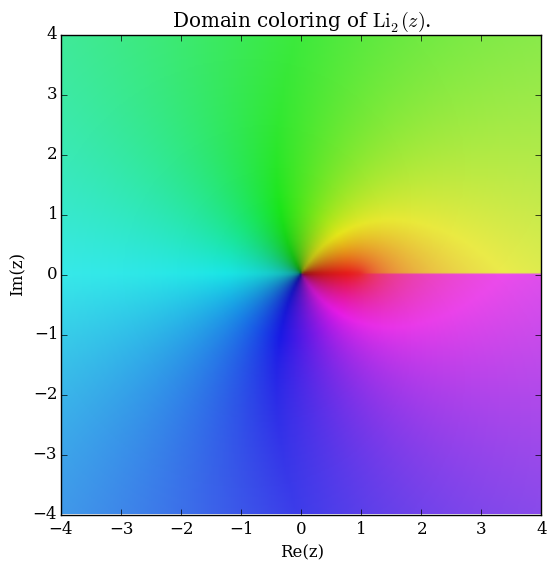Difference between revisions of "Dilogarithm"
From specialfunctionswiki
| (22 intermediate revisions by the same user not shown) | |||
| Line 1: | Line 1: | ||
| − | The dilogarithm is | + | The dilogarithm function $\mathrm{Li}_2$ is defined for $|z| \leq 1$ by |
| − | $$\mathrm{Li}_2(z)=\displaystyle\sum_{k=1}^{\infty} \dfrac{z^k}{k^2} | + | $$\mathrm{Li}_2(z)=\displaystyle\sum_{k=1}^{\infty} \dfrac{z^k}{k^2},$$ |
which is a special case of the [[polylogarithm]]. | which is a special case of the [[polylogarithm]]. | ||
| − | + | <div align="center"> | |
| − | <div | + | <gallery> |
| − | < | + | File:Complexdilogarithmplot.png|[[Domain coloring]] of $\mathrm{Li}_2$. |
| − | + | </gallery> | |
| − | |||
| − | |||
| − | |||
</div> | </div> | ||
| − | < | + | =Properties= |
| − | < | + | [[Relationship between dilogarithm and log(1-z)/z]]<br /> |
| − | + | [[Relationship between Li 2(1),Li 2(-1), and pi]]<br /> | |
| − | + | [[Li 2(1)=pi^2/6]]<br /> | |
| − | + | [[Relationship between Li 2(-1/x),Li 2(-x),Li 2(-1), and log^2(x)]]<br /> | |
| − | + | [[Derivative of Li 2(-1/x)]]<br /> | |
| − | </ | + | [[Li2(z)=zPhi(z,2,1)]]<br /> |
| + | [[Li 2(z)=-Li 2(1/z)-(1/2)(log z)^2 + i pi log(z) + pi^2/3]]<br /> | ||
| − | + | =References= | |
| − | + | * {{BookReference|Higher Transcendental Functions Volume I|1953|Arthur Erdélyi|author2=Wilhelm Magnus|author3=Fritz Oberhettinger|author4=Francesco G. Tricomi|prev=findme|next=Relationship between dilogarithm and log(1-z)/z}}: $\S 1.11.1 (22)$ | |
| − | + | * {{BookReference|Dilogarithms and Associated Functions|1958|Leonard Lewin|next=Taylor series of log(1-z)}}: $(1.1)$ | |
| − | + | * {{BookReference|Handbook of mathematical functions|1964|Milton Abramowitz|author2=Irene A. Stegun|prev=findme|next=Li_2(z)+Li_2(1-z)=pi^2/6-log(z)log(1-z)}}: $27.7.2$ (<i>note: writes $\mathrm{Li}_2$ as $\sum_{k=1}^{\infty} \frac{(-1)^k(x-1)^k}{k^2}$ for $0 \leq x \leq 2$, equivalent to our definition on $\mathbb{R}$</i>) | |
| − | + | * {{BookReference|Polylogarithms and Associated Functions|1981|ed=2nd|edpage=Second Edition|Leonard Lewin|next=Taylor series of log(1-z)}}: $(1.1)$ | |
| − | + | * {{BookReference|Structural Properties of Polylogarithms|1991|Leonard Lewin|next=Relationship between dilogarithm and log(1-z)/z}}: $(1.1)$ | |
| − | |||
| − | + | [http://authors.library.caltech.edu/43491/1/Volume%201.pdf (page 31)]<br /> | |
| − | + | [http://maths.dur.ac.uk/~dma0hg/dilog.pdf The Dilogarithm function]<br /> | |
| − | + | [http://people.mpim-bonn.mpg.de/zagier/files/doi/10.1007/978-3-540-30308-4_1/fulltext.pdf]<br /> | |
| − | < | ||
| − | |||
| − | |||
| − | </ | ||
| − | |||
| − | |||
| − | |||
| − | |||
| − | |||
| − | |||
| − | |||
| − | </ | ||
| − | + | {{:Logarithm and friends footer}} | |
| − | |||
| − | |||
| − | |||
| − | |||
| − | |||
| − | |||
| − | + | [[Category:SpecialFunction]] | |
| − | [ | ||
| − | |||
Latest revision as of 23:22, 3 March 2018
The dilogarithm function $\mathrm{Li}_2$ is defined for $|z| \leq 1$ by $$\mathrm{Li}_2(z)=\displaystyle\sum_{k=1}^{\infty} \dfrac{z^k}{k^2},$$ which is a special case of the polylogarithm.
Domain coloring of $\mathrm{Li}_2$.
Properties
Relationship between dilogarithm and log(1-z)/z
Relationship between Li 2(1),Li 2(-1), and pi
Li 2(1)=pi^2/6
Relationship between Li 2(-1/x),Li 2(-x),Li 2(-1), and log^2(x)
Derivative of Li 2(-1/x)
Li2(z)=zPhi(z,2,1)
Li 2(z)=-Li 2(1/z)-(1/2)(log z)^2 + i pi log(z) + pi^2/3
References
- 1953: Arthur Erdélyi, Wilhelm Magnus, Fritz Oberhettinger and Francesco G. Tricomi: Higher Transcendental Functions Volume I ... (previous) ... (next): $\S 1.11.1 (22)$
- 1958: Leonard Lewin: Dilogarithms and Associated Functions ... (next): $(1.1)$
- 1964: Milton Abramowitz and Irene A. Stegun: Handbook of mathematical functions ... (previous) ... (next): $27.7.2$ (note: writes $\mathrm{Li}_2$ as $\sum_{k=1}^{\infty} \frac{(-1)^k(x-1)^k}{k^2}$ for $0 \leq x \leq 2$, equivalent to our definition on $\mathbb{R}$)
- 1981: Leonard Lewin: Polylogarithms and Associated Functions (2nd ed.) ... (next): $(1.1)$
- 1991: Leonard Lewin: Structural Properties of Polylogarithms ... (next): $(1.1)$
(page 31)
The Dilogarithm function
[1]
